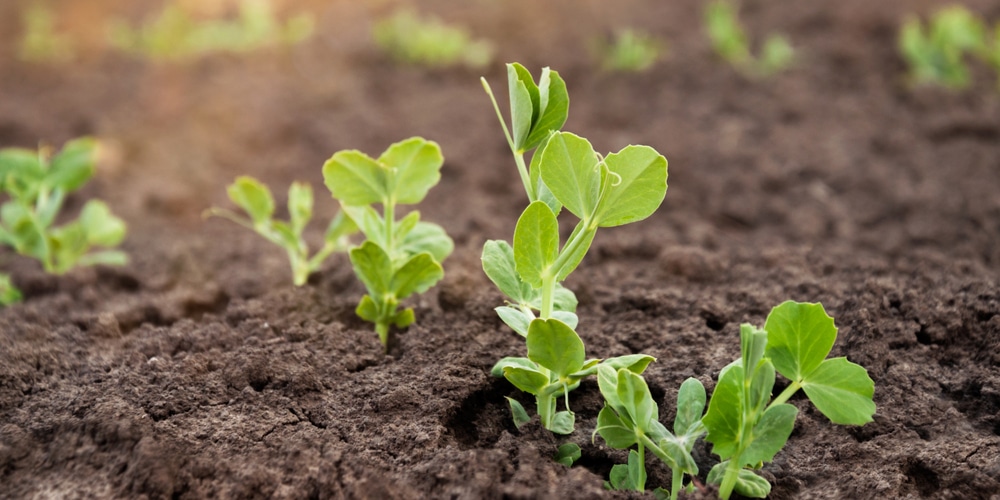Utah is a landlocked state in the Western region of the United States. With majestic mountain ranges and sprawling valleys, it’s no wonder why Utah is nicknamed “The Beehive State.” Despite its arid climate, many types of plants can be successfully grown in Utah. Peas are not an exception!
Peas make an excellent addition to any garden, as they are relatively easy to grow and are quite versatile. Growing peas in Utah can be challenging due to the state’s high altitude and low humidity, but with little planning and care, it is certainly possible to produce a bountiful crop.
Luckily, peas grow and thrive in a wide range of climates and soil types, so they are well-suited to the conditions found in Utah. Garden peas, dry peas, and snow peas have their own variety that can be grown in the state.
When is the Best Time to Plant Peas in Utah?

Depending on the type of pea you want to grow, the best time to plant peas in Utah will vary. Garden peas and snow peas are cool-weather crops, so they should be planted as early as possible in the spring, as soon as the ground can be worked. Don’t worry about a little bit of frost – these peas are quite tolerant of cold weather and can take a mild freeze.
Dry peas, on the other hand, are a warm-weather crop and should be planted in late spring or early summer. These peas need warmer temperatures to mature properly, so planting them too early in the season can result in poor yields.
How to Plant Peas in Utah: Things to Consider
Remember that peas are a cool-weather crop, so you’ll need to consider the state’s high altitude and low humidity when planning your planting. Growing peas require more than just watering and fertilizing – here are a few things to consider before planting your peas in Utah:
Choose a Site That Gets Full Sun
When choosing a site to plant your peas, it’s essential to select an area that gets full sun. Peas need at least six hours of sunlight each day to produce a good crop.
If you live in an area with hot summers, you may want to choose a site that gets some afternoon shade. This will help prevent the peas from getting too much sun and helps them stay cool.
Prepare the Soil
The soil in Utah is generally alkaline, so it’s important to take this into account when preparing the soil for your peas. You’ll need to add some organic matter to the soil to help lower the pH and make it more acidic.
This can be done by adding compost or peat moss to the planting area. Additionally, you may want to add some limestone to the soil to help raise the pH.
In addition to being acidic, the soil in Utah is also quite dry. Peas need loose, well-drained soil to grow properly. You can improve the drainage of your soil by adding organic matter such as compost or peat moss.
It’s also a good idea to raise beds or mounds when planting peas, as this will help improve drainage even further.
Water, Water, Water
Unlike other parts of the country, where regular rainfall and precipitation are generally enough to keep plants healthy, gardeners in Utah need to be more proactive. Peas thrive in moist conditions, so it is essential to make sure that they get plenty of water during the early growing stages.
This can be accomplished by frequently irrigating with a drip system or by hand-watering at least twice per day. You may also want to consider installing a micro-irrigation system for optimal results, especially if your climate is particularly dry.
Start Planting!
Once you’ve prepared the soil and chosen a site, it’s time to plant your peas! If you’re planting garden peas or snow peas, plant them as soon as the ground can be worked in the spring. These peas do best when planted directly in the ground, so there’s no need to start them indoors.
Peas are best planted in rows, with each seed about two inches apart. Once the seeds have been planted, cover them with a thin layer of soil and water gently. Be sure to keep the peas watered during the early growing stages – they need moist conditions to thrive.
Plant Peas in Utah: Final Thoughts
With a little bit of planning and preparation, you can successfully plant peas in Utah. Just remember to choose a site that gets full sun, prepare the soil properly, and water frequently during the early growing stages.
By following these simple tips, you’ll be on your way to harvesting a bountiful crop of peas in no time!
Related Article: When to Plant Tomatoes in Utah?
